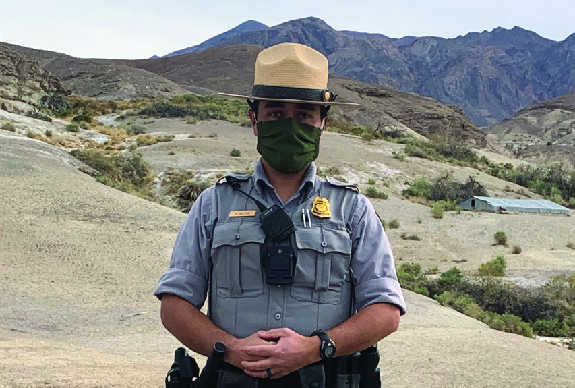
SAVING LIVES IN DEATH VALLEY Law Enforcement Ranger Max Gallegos provides EMS, enforces laws and fights fires on 3.4 million acres of national park land.
He’s part EMT, part park ranger and part law enforcement officer: Meet Max Gallegos, a law enforcement ranger in Death Valley National Park. Gallegos plays a crucial role in protecting the park’s 3.4 million acres of California and Nevada desert and the 1.7 million people who visit it each year.
Despite its ominous name, Death Valley is full of life—with busy campgrounds, popular hiking trails and bustling resorts. A place of extremes, Death Valley is the hottest, driest and lowest place in North America, yet it can be exceptionally cold in the winter, and sudden storms can produce unexpected flooding in the basin floor.
So what does EMS look like somewhere that’s both beautiful and dangerous? “It’s great,” says Gallegos, a native of New Mexico. “But it’s a lot of land to cover with limited resources, so it can sometimes feel overwhelming.” Gallegos spends most of his time in his vehicle and sometimes drives 200 to 300 miles a day.
Gallegos and his colleagues are responsible for all medical response inside the park, which is roughly the size of Connecticut. Every ranger working in the park is an EMT, a paramedic or part of the National Park Service’s ParkMedic program. Several, including Gallegos, are also firefighters, responding to structural and wildland fires, motor vehicle accidents, hazmat incidents and other emergencies.
TRAINING FOR THE PARK SERVICE
In 2017, Gallegos went through the ParkMedic program, which the National Park Service runs in partnership with UCSF Fresno. ParkMedics are certified as Nationally Registered Advanced-EMTs, with an enhanced scope of practice within Park Service boundaries. More recently, he trained to become a law enforcement ranger.
“A law enforcement ranger is a one-stop-shop for pretty much everything,” Gallegos explains. “We enforce federal rules and regulations to protect public lands and resources from things like poaching or theft of minerals or driving off-road. We also enforce the more typical criminal issues, such as burglary, DUIs and speeding tickets.”
Gallegos explains that rangers are in charge of search and rescue for lost or injured visitors, and they help with the occasional maintenance projects, litter cleanup, vehicle problems and wildlife management.
“If it happens in the park, chances are we’re helping out somehow,” he says.
JACK-OF-ALL-TRADES JOB
In an environment where temperatures regularly soar past 120 degrees, the most common EMS calls for Gallegos are related to heat-related illnesses, but he also sees his share of falls and car accidents. Death Valley operates two ambulances within the park, but the nearest hospital is almost 90 minutes away, so park EMS sometimes relies on helicopters for transport.
Gallegos got his start in EMS prior to joining the Park Service, with stints at a fire department in his native New Mexico, the US Forest Service in California and a private ambulance company. He also spent one season working at Yosemite National Park prior to Death Valley.
“I like that every day is a fresh set of circumstances,” he says. He may spend a day helping fix a flat tire, rescuing a stray bird and getting a drunk driver off the road. “This job is one of the few remaining jack-of-all trades professions left in the world, and because I’ve done lots of very different things throughout my life, I’m a generalist. I’m good at troubleshooting random circumstances and obstacles.“
Although the austere environment of Death Valley means Gallegos and his colleagues often respond to serious vehicle crashes, wildfires and difficult technical rescues from helicopters, his biggest challenges as an EMS practitioner resemble the ones faced by EMS practitioners everywhere.
“The more I think about it, the thing that’s often the trickiest is mental health emergencies,” he says. “Those situations require a lot of the ‘soft’ skills that are not often taught and usually require some combination of interpersonal skill and depth of experience.”
Unfortunately, Death Valley attracts a number
of suicidal individuals. Gallegos says some of his hardest days are those dealing with mental health crises. “You have to spend time, have patience, exercise empathy and build rapport with someone who is going through something you often cannot do anything about, but can only guide them to
a space where they hopefully feel safe until they reach professional help.”
Working for the National Park Service, Gallegos has been impressed by the sense of responsibility and duty that he shares with his colleagues. “I think, like most people, Park Service employees take pride in their work,” he says, “but being here alongside everyone, it’s really amazing how strongly everyone feels about protecting and conserving public lands and the care and stewardship they feel.”
